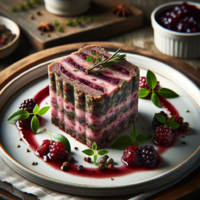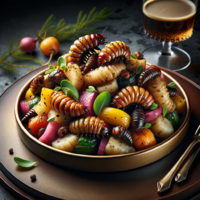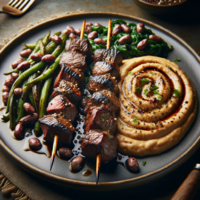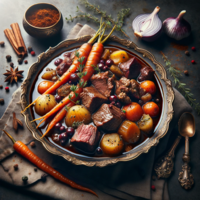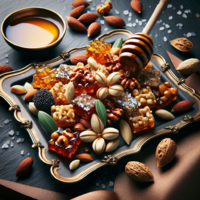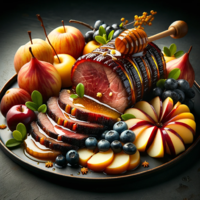Wolgos Cuisine and Cuisine in Hergom
Characteristics
Wolgos cuisine and palate are profoundly intertwined with their dietary evolution and Neolithic history. As a subspecies with a predatory history, the Wolgos have developed distinct dietary preferences that set them apart from humans. Their culinary choices reflect their past as hunters and raiders of human tribes, as well as their adaptation to a more protein-centric diet. The Wolgos favour a diet that is significantly richer in animal protein compared to humans. They tend to eschew simple carbohydrates like bread, rice, and pasta. Instead, their carbohydrate sources are primarily derived from semi-starchy tubers and vegetables. This dietary shift is a result of their historical reliance on animal and human meat as their primary source of sustenance.
One notable characteristic of Wolgos cuisine is their preference for savoury flavours over sweetness. They often find traditional human cuisine to be overly sweet, as it relies heavily on carbohydrates like bread and potatoes. Refined sugar treats and desserts are generally less appealing to the Wolgos, who instead gravitate towards savoury and nutty treats, occasionally sweetened with honey or natural fruits such as berries.
The Wolgos' prehistory as predators of humans influenced their approach to food preservation and preparation. When raiding human tribes, they often acquired early agricultural produce that had a tendency to spoil over time. To combat this, the Wolgos developed techniques for controlled spoilage and fermentation. Preserving or fermenting meats, in particular, became a popular choice in their cuisine. Another intriguing aspect of Wolgos cuisine is their utilization of arthropods such as maggots and weevils. As the foods they obtained from humans often spoiled during extended periods, they came into contact with arthropods that fed on these spoils. The Wolgos learned to harvest and use these arthropods as a valuable source of protein. These insects not only provided protein but also transformed less desirable carbohydrate-rich spoils into a more desirable protein source.
Present-day Wolgos cuisine is characterized by a preference for bold and intense flavours, including strong sour, acidic, and deep pungent notes. Gamy and robust umami flavours, sourced from various protein-rich ingredients, hold a special place in their culinary repertoire. To balance and complement these strong flavours, the Wolgos often incorporate palate-cleansing and milder elements into their dishes. These include vegetables, cheese, milk curds, and starchy tubers, creating a harmonious blend of taste experiences.
While some human cultures may not fully appreciate Wolgos cuisine due to its unique flavour profile and preferences, others have found it to be intriguing and enjoyable. One notable aspect of Wolgos cuisine is its potential to promote ketosis in humans. The emphasis on protein-rich ingredients and the avoidance of high-carbohydrate foods align with ketogenic metabolic pathways. However, it's worth noting a cautionary point regarding Wolgos breads. Some of their bread varieties may contain ergot, a fungus known for its toxic effects. Humans should exercise caution and avoid consuming Wolgos breads that are exotic and potentially ergot-contaminated.
Foods
Meats & Arthropods

Wolgos cuisine is undeniably cantered around meat, and the Wolgos people have cultivated a profound and expansive culture dedicated to the production and refinement of meat products. Over time, their culinary preferences have evolved, transitioning from a preference for game meat to a broader array of choices as their population grew and agricultural practices became established.
Among the most notable sources of meat for the Wolgos are Aurochs and dairy Aurochs. These creatures are highly favoured and are commonly featured in the offerings of Wolgos butchers. Their meat is widely consumed among the Wolgos population. However, the Wolgos have always had a penchant for culinary diversity, leading them to raise a variety of livestock. This includes sheep, pork, wild boar, rabbit, as well as a diverse assortment of poultry and game birds. These animals are commercially raised to cater to the Wolgos' desire for a wide-ranging and dynamic culinary experience.
A distinctive aspect of Wolgos cuisine is their preference for rats and mice as a source of meat. These small rodents are not only cost-effective but also widely favoured over chicken in various culinary applications. One particularly popular Wolgos snack involves the pickling or battering and frying of new-born mice, offering a unique and readily available fast-food option.
Arthropods hold a special place in the hearts and palates of the Wolgos people. The giant wood grubs native to their homeland are highly sought after. These grubs, often referred to as "Wolgos eggs" due to their palm-sized proportions, offer a culinary delight. When burst, they release their thick yolk innards, which can be consumed both raw and cooked, providing a distinctive and flavorful experience. Maggots, cultivated on various substrates including meat, cheese, and vegetables, offer diverse flavour profiles. The oily residue left behind by maggots, after feasting on decomposing meat or cheese, is considered a prized condiment. Earthworms and a variety of beetles are also raised for use in minced preparations, stuffing, patties, and sausages.
Preservation Techniques
Meat preservation techniques are an essential aspect of Wolgos cuisine. Freshness is highly valued, but controlled decomposition processes are also cherished. Fermentation, in particular, is a widely adopted method, with meats fermented in various ways, including the use of jars or burial in alkali or acidic soils. These fermentation processes have given rise to gourmet delicacies. Additionally, pickling meat, either individually or in combination with spices and fruits, is a popular choice among the Wolgos.
Waste is minimized in Wolgos cuisine, and every part of an animal is esteemed for its gourmet value. All organs, except for dangerous endocrine organs, are considered edible. Bone marrow is particularly popular and is often processed into broths that are consumed as beverages. This culinary philosophy of utilizing every part of an animal reflects the Wolgos people's resourcefulness and reverence for the bounty they obtain from their environment.
Mushrooms
Vegetables
Tubers and breads

Drinks
Wolgos beverages are a fascinating reflection of a culinary tradition that prizes depth and complexity of flavors. At the heart of their beverage culture lies a penchant for rich and intense tastes, achieved through the use of high-tannin roots, flowers, berries, and the incorporation of savoury meat and bone broths.

One standout favourite among the Wolgos people is chamomile. This delicate and aromatic flower is a cherished ingredient in their beverage repertoire and is found in a myriad of forms. However, its most notable incarnation is as a cold infusion. Chamomile is esteemed not only for its soothing and calming properties but also for its distinctive and fragrant flavour, making it a popular choice for moments of relaxation and reflection.
Soft drinks in Wolgos cuisine deviate from the typical sugary sodas prevalent in other regions. Instead, they are crafted with finesse, often flavoured with a selection of intriguing ingredients such as chamomile, sarsaparilla root, spiced tea, and even marrow broth. What sets these soft drinks apart is their mild sweetness; the Wolgos people tend to find foreign sweet soft drinks overwhelmingly and sickly sweet in comparison.
Milk and fermented milk drinks enjoy immense popularity among the Wolgos. These beverages come in a captivating range of textures and flavours, catering to a variety of preferences. Whether consumed in its pure form or infused with the vibrant essence of berries or tangy fruits like mango or passion fruit, milk and fermented milk drinks offer a harmonious balance of creamy richness and subtle acidity.
Whey, a by-product of cheese-making, has also found a special place in the hearts and glasses of the Wolgos people. This refreshing drink can be enjoyed slightly salted or mildly sweetened, but many prefer it in its natural, chilled form. In recent decades, carbonated versions have become increasingly available, offering a bubbly twist to this traditional favourite. Whey is often the go-to drink during everyday meals, providing a refreshing and invigorating accompaniment.
Hot beverages hold a prominent role in Wolgos culture as well. Teas and infusions, often spiced with aromatic elements like cinnamon, aniseed, cloves, and other spices, warm both the body and the spirit. Coffee, another beloved choice, can be enjoyed with milk for a smoother profile or prepared straight in hot milk for those who savour its sharp bitterness.
Cheese
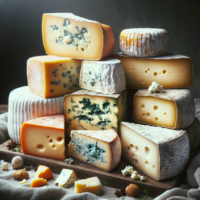
Fermentation
Alcohol
The Wolgos have a deep-rooted history of alcoholic beverage consumption, and their relationship with alcohol is as diverse as it is culturally significant. Over time, some foreign influences, particularly from the northern regions of Anaria, have become integrated into their drinking traditions. Notably, beer and lagers have found a place in Wolgos culture, blending with their indigenous alcoholic offerings.
Traditionally, the Wolgos people have had a preference for distilling fermented grains into potent spirits, akin to vodka. These strong and robust spirits have been a cornerstone of their drinking culture for generations, celebrated for their potency and versatility in crafting various libations.
Given their penchant for milk and milk products, the Wolgos have ingeniously fermented dairy to produce a range of high-proof spirits. This innovation has resulted in an array of dairy-based alcoholic beverages, which can be enjoyed in their pure form or used as a base for further creations. Fermented milk drinks reminiscent of kumis have also found favour among the Wolgos. These beverages, often slightly effervescent and mildly alcoholic, are sometimes enhanced with added spirits for an extra kick. This unique blend of fermented milk and strong spirits creates a drink that is both refreshing and potent, offering a one-of-a-kind taste experience.
One distinctive aspect of Wolgos alcoholic drinks is their propensity to incorporate milk or milk-based products as a base. These creamy foundations provide a velvety backdrop for a wide array of flavourings, including fruits, coffee, chocolate, and even pine berries.
